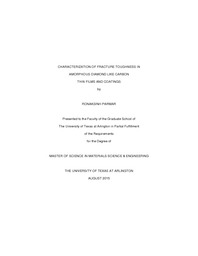
ATTENTION: The works hosted here are being migrated to a new repository that will consolidate resources, improve discoverability, and better show UTA's research impact on the global community. We will update authors as the migration progresses. Please see MavMatrix for more information.
Show simple item record
| dc.contributor.author | Parmar, Ronaksinh | en_US |
| dc.date.accessioned | 2015-12-11T23:20:10Z | |
| dc.date.available | 2015-12-11T23:20:10Z | |
| dc.date.issued | 2015 | |
| dc.date.submitted | January 2015 | en_US |
| dc.identifier.other | DISS-13320 | en_US |
| dc.identifier.uri | http://hdl.handle.net/10106/25385 | |
| dc.description.abstract | Any material containing a crack when subjected to a certain amount of load, will eventually fail. This failure of material can be either time consuming (ductile) or instant (brittle) depending on the type of material and amount of load applied. For one to be able to study fracture toughness, it is important to study the material's failure rate and how long it can withstand load without failure once a crack has been initiated. Ductile materials demonstrate high fracture toughness while brittle materials show lower fracture toughness and fail instantly once a crack has been initiated. Characterization of fracture toughness in bulk materials is easy and well established. However, it becomes difficult when dealing with brittle thin films. As the coating thickness decreases below ~1 μm, it becomes increasingly difficult to evaluate fracture toughness using conventional methods. Bulk materials can also be machined easily for making test specimen but Diamond like Carbon (DLC) thin films cannot be synthesized in bulk. Micro and nano-indentation techniques are proposed for cases where conventional tension test and impact test fails to evaluate fracture toughness. Indentation techniques are very well developed for hardness measurement in all types of materials. This paper is focusing towards characterization of fracture toughness in brittle (100) single crystal Silicon (Si) and DLC films coated on Si substrate. Such DLC thin films are designed to enhance thermal, oxidation, corrosion and mechanical resistance of substrate materials. Though sometimes service lifetime of such coatings in applications is limited by their fracture resistance or fracture toughness. Indentation is an easy, inexpensive, and non-destructive method for mechanical characterization for small volume of material. Such indentation is made using three sided or four sided diamond tip like, Vickers and cube-corner. Fracture toughness can be evaluated by analyzing the radial cracks formed by this indentation. Presence of DLC coating reduces the radial crack length compared to crack length observed in uncoated Si. Different indentation models are used for characterization of fracture toughness in DLC thin films and Si wafer. It is found that the strain energy release model is most appropriate for evaluating fracture toughness in these films. The most challenging part of this research was to understand the effect of substrate on thin films and a way to evaluate the fracture toughness of thin films without the influence of substrate material. | en_US |
| dc.description.sponsorship | Meletis, Efstathios | en_US |
| dc.language.iso | en | en_US |
| dc.publisher | Materials Science & Engineering | en_US |
| dc.title | Characterization Of Fracture Toughness In Amorphous Diamond Like Carbon Thin Films And Coatings | en_US |
| dc.type | M.S. | en_US |
| dc.contributor.committeeChair | Meletis, Efstathios | en_US |
| dc.degree.department | Materials Science & Engineering | en_US |
| dc.degree.discipline | Materials Science & Engineering | en_US |
| dc.degree.grantor | University of Texas at Arlington | en_US |
| dc.degree.level | masters | en_US |
| dc.degree.name | M.S. | en_US |
Files in this item
- Name:
- Parmar_uta_2502M_13320.pdf
- Size:
- 1.838Mb
- Format:
- PDF
This item appears in the following Collection(s)
Show simple item record


